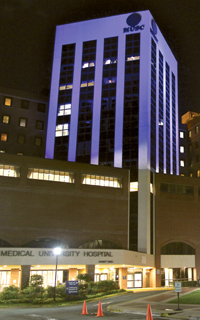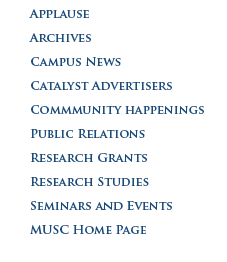|
The North Tower
at MUSC glowed blue April 2 as the
campus joined Autism Speaks'
worldwide initiative to "Light It
Up Blue" to raise awareness about
autism.
 MUSC's North Tower
lights up blue April 2 for
autism awareness. MUSC's North Tower
lights up blue April 2 for
autism awareness.
The symbolic
act, done in sync with iconic
landmarks around the world such as
the Empire State Building, came
just as the Centers for Disease
Control and Prevention released a
new study that estimates that 1 in
88 children in the United States
has been identified as having an
autism spectrum disorder (ASD).
Autism spectrum disorders are
almost five times more common
among boys than girls – with 1 in
54 boys identified.
The data comes
from 14 communities across the
United States and includes
monitoring work being done in
South Carolina by MUSC. Jane
Charles, M.D., Department of
Pediatrics, and Joyce Nicholas,
Ph.D., Biostatistics and
Epidemiology, oversee MUSC's
Autism and Developmental
Disabilities Monitoring Network
(ADDM) study.
Walter Jenner,
information officer for the SC
ADDM project said, the numbers
have almost doubled since we
started monitoring ASD in 2000
which has surprised him. He
expected it to level off. "It's
five times as common in boys.
That's kind of scary. It's
certainly on people's minds now."
Study results
from the 2008 surveillance year
show 11.3 per 1,000 8-year-old
children have been identified as
having an ASD. This marks a 23
percent increase since the last
report in 2009. Some of this
increase is due to the way
children are identified, diagnosed
and served in their communities,
although exactly how much is due
to these factors is unknown
Coleen Boyle,
Ph.D., director of CDC's National
Center on Birth Defects and
Developmental Disabilities, said
to understand more, health
professionals need to keep
accelerating research into risk
factors and causes of autism
spectrum disorders.
The study also
shows more children are being
diagnosed by age 3, an increase
from 12 percent for children born
in 1994 to 18 percent for children
born in 2000. "Unfortunately, 40
percent of the children in this
study aren't getting a diagnosis
until after age 4. We are working
hard to change that," said Boyle.
MUSC autism
experts hope to change that as
well.
Jenner, an
advocate for early assessment of
children, is the ADDM ambassador
of the Learn the Signs Act Early
program, which educates people on
the importance of early diagnosis
and prevention. "Because autism is
assessed based on developmental
behaviors, it can be diagnosed in
children as young as 18 months
old. If children are diagnosed at
a young age, they can be treated
to help improve symptoms earlier,"
he said.
Although there
is no medical detection or cure,
there are several research
initiatives that are being
conducted to find what exactly
causes autism. Understanding the
characteristics and number of
children on the autism spectrum is
essential to promoting the
awareness of the condition,
helping educators to plan special
services, and identifying
important signs for further
research.
 Members of the ADDM
team show their "blue" spirit
for Autism Speaks' Light It Up
Blue autism awareness day. Members of the ADDM
team show their "blue" spirit
for Autism Speaks' Light It Up
Blue autism awareness day.
Jenner said
that prevalence studies such as
these point out the need for more
research, especially given that
almost every scientist now agrees
that there are environmental
triggers involved as well as
genetic factors in causing ASD. In
the meantime, the study can be
used to inform service providers
how much to gear up much needed
community support for the people
affected by ASD.
"More attention
will bring more resources to
discover what's really going on.
Down the road maybe it will mean
finding a cure. That's what we all
hope for."
Early
Detection Primer
The most important thing for
parents to do is to act quickly
whenever there is a concern about
a child's development. CDC offers
these tips:
- Talk
to your child's doctor about
your concerns.
- Call
your local early intervention
program or school system for
an assessment.
- Remember
you do not need a diagnosis to
access services for your
child.
For more
information about this study,
visit http://www.cdc.gov/autism.
For information
on CDC's tools to help families
track their child's development,
visit http://www.cdc.gov/actearly.
To learn more
about MUSC autism work: visit
MUSC's Project Rex at http://www.projectrex.org
and MUSC's Developmental -
Behavioral Pediatrics at http://clinicaldepartments.musc.edu/pediatrics/divisions/developmentalpeds/index.htm.
|



 MUSC's North Tower
lights up blue April 2 for
autism awareness.
MUSC's North Tower
lights up blue April 2 for
autism awareness. Members of the ADDM
team show their "blue" spirit
for Autism Speaks' Light It Up
Blue autism awareness day.
Members of the ADDM
team show their "blue" spirit
for Autism Speaks' Light It Up
Blue autism awareness day.